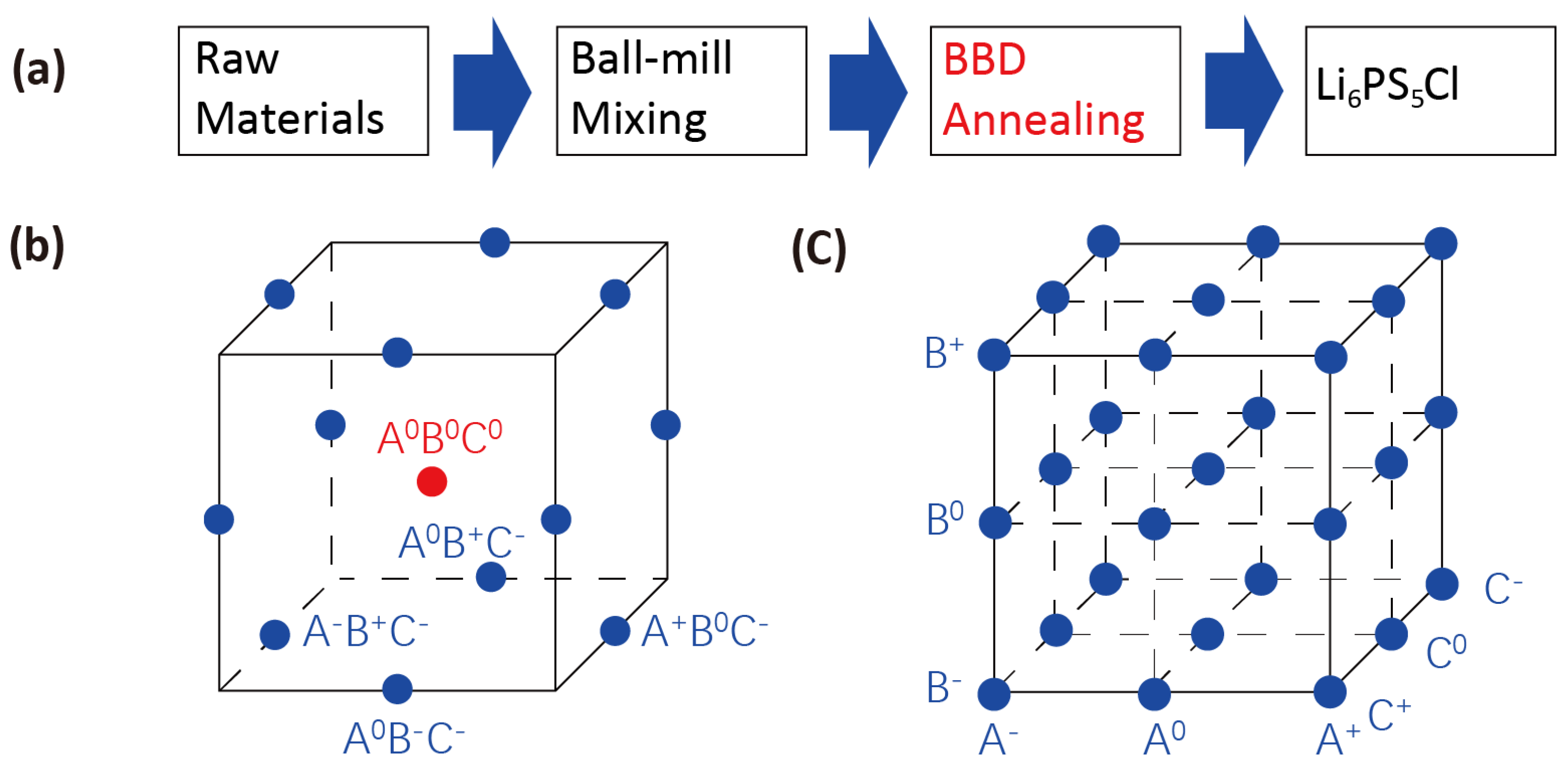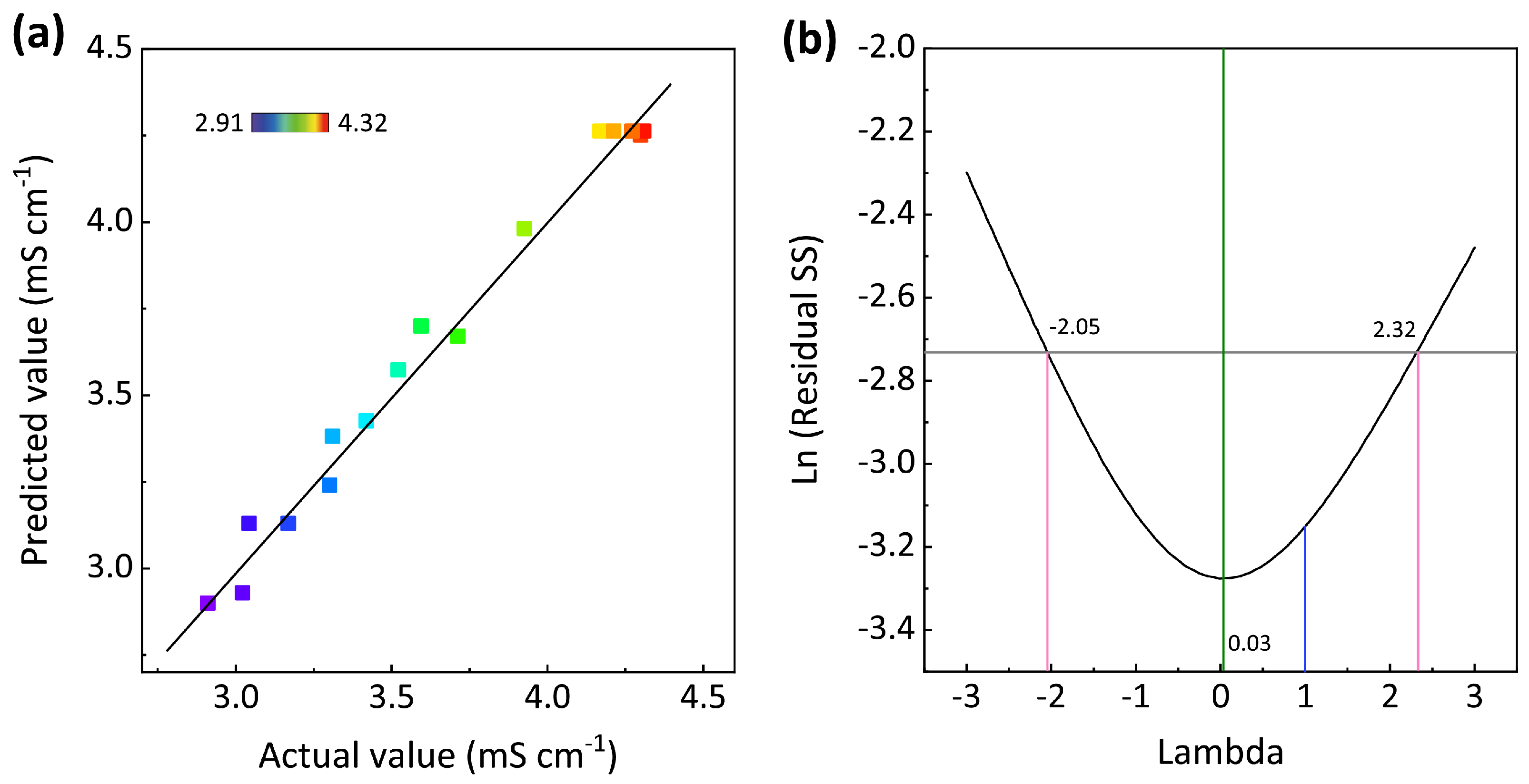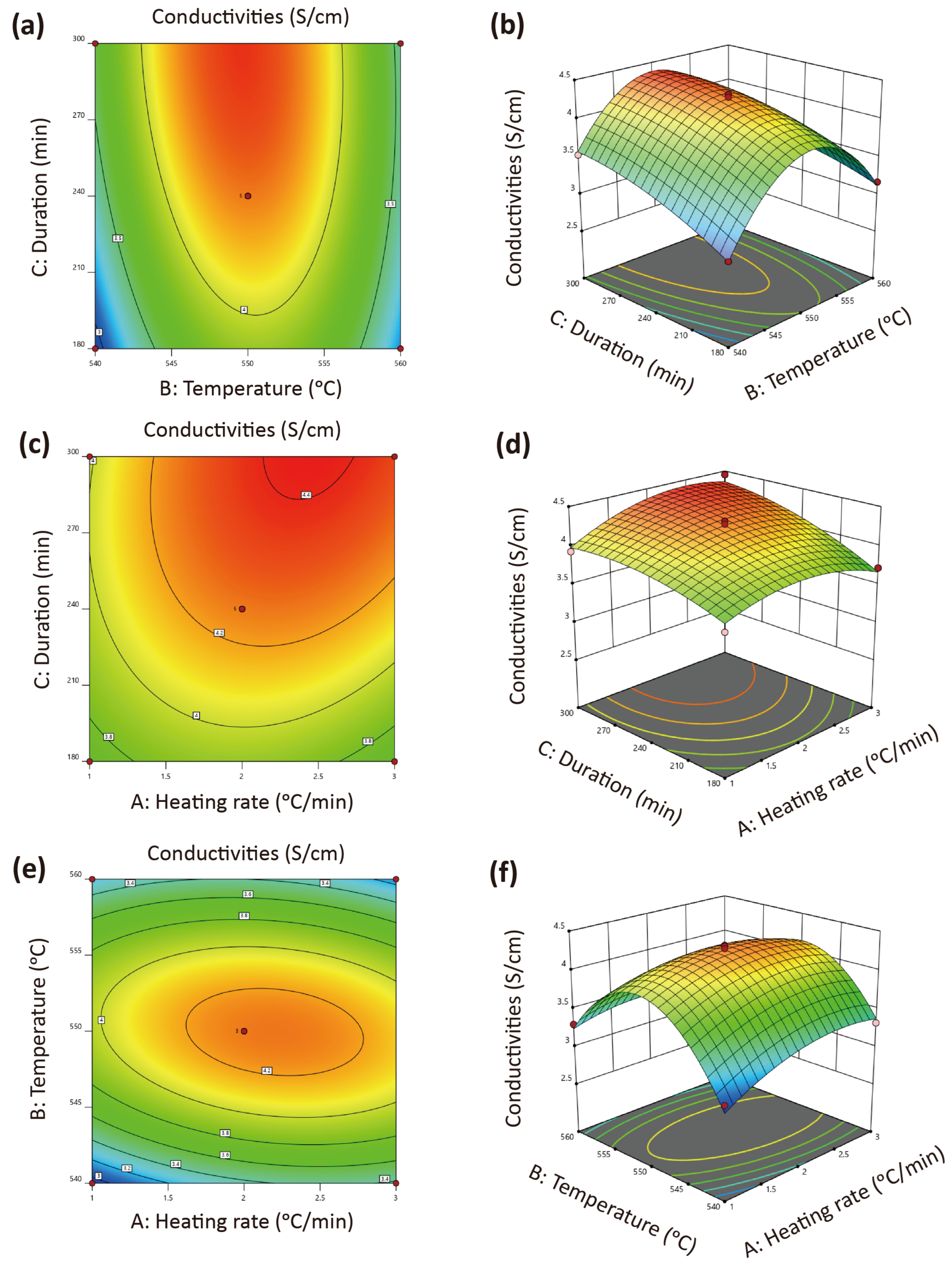Optimization of Annealing Process of Li6PS5Cl for All-Solid-State Lithium Batteries by Box–Behnken Design
Abstract
:1. Introduction
2. Materials and Methods
2.1. Materials
2.2. Preparation of Li6PS5Cl Precursor
2.3. Material Characterization
2.4. Cell Assembly
2.5. Electrochemical Measurements
2.6. Response Surface Methodology
3. Results
4. Conclusions
Author Contributions
Funding
Data Availability Statement
Conflicts of Interest
References
- Zhang, S.; Zhao, F.; Chen, J.; Fu, J.; Luo, J.; Alahakoon, S.H.; Chang, L.Y.; Feng, R.; Shakouri, M.; Liang, J.; et al. A family of oxychloride amorphous solid electrolytes for long-cycling all-solid-state lithium batteries. Nat. Commun. 2023, 14, 3780. [Google Scholar] [CrossRef] [PubMed]
- Yin, Y.C.; Yang, J.T.; Luo, J.D.; Lu, G.X.; Huang, Z.; Wang, J.P.; Li, P.; Li, F.; Wu, Y.C.; Tian, T.; et al. A LaCl3based lithium superionic conductor compatible with lithium metal. Nature 2023, 616, 77–83. [Google Scholar] [CrossRef] [PubMed]
- Zhang, Z.; Wang, J.; Jin, Y.; Liu, G.; Yang, S.; Yao, X. Insights on lithium plating behavior in graphite-based all-solid-state lithium-ion batteries. Energy Storage Mater. 2023, 54, 845–853. [Google Scholar] [CrossRef]
- Wu, Z.K.; Chen, S.Q.; Yu, C.; Wei, C.C.; Peng, L.F.; Wang, H.L.; Cheng, S.J.; Xie, J. Engineering high conductive Li7P2S8I via Cl- doping for all-solid-state Li-S batteries workable at different operating temperatures. Chem. Eng. J. 2008, 10, 142–149. [Google Scholar] [CrossRef]
- Wu, Y.Q.; Zhou, K.; Ren, F.C.; Ha, Y.; Liang, Z.T.; Zheng, X.F.; Wang, Z.Y.; Yang, W.; Zhang, M.J.; Luo, M.Z.; et al. Highly reversible Li2RuO3 cathodes in sulfide-based all solid-state lithium batteries. Energy Environ. Sci. 2022, 15, 3470–3482. [Google Scholar] [CrossRef]
- Su, J.; Pasta, M.; Ning, Z.Y.; Gao, X.W.; Bruce, P.G.; Grovenor, C.R.M. Interfacial modification between argyrodite-type solid-state electrolytes and Li metal anodes using LiPON interlayers. Energy Environ. Sci. 2022, 15, 3805–3814. [Google Scholar] [CrossRef]
- Yu, C.; Zhao, F.; Luo, J.; Zhang, L.; Sun, X. Recent development of lithium argyrodite solid-state electrolytes for solid-state batteries: Synthesis, structure, stability and dynamics. Nano Energy 2021, 83, 105858. [Google Scholar] [CrossRef]
- Yu, C.; Li, Y.; Willans, M.; Zhao, Y.; Adair, K.R.; Zhao, F.; Li, W.; Deng, S.; Liang, J.; Banis, M.N.; et al. Superionic conductivity in lithium argyrodite solid-state electrolyte by controlled Cl-doping. Nano Energy 2020, 69, 104396. [Google Scholar] [CrossRef]
- Zhang, Z.; Zhang, L.; Liu, Y.; Yu, C.; Yan, X.; Xu, B.; Wang, L.-M. Synthesis and characterization of argyrodite solid electrolytes for all-solid-state Li-ion batteries. J. Alloys Compd. 2018, 747, 227–235. [Google Scholar] [CrossRef]
- Zhou, L.; Park, K.-H.; Sun, X.; Lalère, F.; Adermann, T.; Hartmann, P.; Nazar, L.F. Solvent-Engineered Design of Argyrodite Li6PS5X (X = Cl, Br, I) Solid Electrolytes with High Ionic Conductivity. ACS Energy Lett. 2018, 4, 265–270. [Google Scholar] [CrossRef]
- Zhao, C.G.; Lyu, M.M.; Bi, C.J.; Huo, S.D.; Li, S.R.; Xue, W.D. Synthesis of high ionic conductivity Li6PS5Cl solid electrolyte by second sintering process. Results Chem. 2022, 4, 100468. [Google Scholar] [CrossRef]
- Ferreira, S.L.C.; Bruns, R.E.; Ferreira, H.S.; Matos, G.D.; David, J.M.; Brandão, G.C.; da Silva, E.G.P.; Portugal, L.A.; dos Reis, P.S.; Souza, A.S.; et al. Box-Behnken design: An alternative for the optimization of analytical methods. Anal. Chim. Acta 2007, 597, 179–186. [Google Scholar] [CrossRef] [PubMed]
- Pinto, D.; Vieira, E.F.; Peixoto, A.F.; Freire, C.; Freitas, V.; Costa, P.; Delerue-Matos, C.; Rodrigues, F. Optimizing the extraction of phenolic antioxidants from chestnut shells by subcritical water extraction using response surface methodology. Food Chem. 2021, 334, 127521. [Google Scholar] [CrossRef] [PubMed]
- Hooda, A.; Nanda, A.; Jain, M.; Kumar, V.; Rathee, P. Optimization and evaluation of gastroretentive ranitidine HCl microspheres by using design expert software. Int. J. Biol. Macromol. 2012, 51, 691–700. [Google Scholar] [CrossRef] [PubMed]
- Chaker, H.; Ameur, N.; Saidi-Bendahou, K.; Djennas, M.; Fourmentin, S. Modeling and Box-Behnken design optimization of photocatalytic parameters for efficient removal of dye by lanthanum-doped mesoporous TiO2. J. Environ. Chem. Eng. 2021, 9, 104584. [Google Scholar] [CrossRef]
- Azizi, A.; Seyyed Alizade Ganji, S.M. Relative floatability as a criterion for evaluating the separation performance of phosphate from iron. Int. J. Min. Sci. Technol. 2017, 27, 451–458. [Google Scholar] [CrossRef]
- Khusro, A.; Aarti, C.; Agastian, P. Microwave irradiation-based synthesis of anisotropic gold nanoplates using Staphylococcus hominis as reductant and its optimization for therapeutic applications. J. Environ. Chem. Eng. 2020, 8, 104526. [Google Scholar] [CrossRef]
- Zhang, N.; Bénard, P.; Chahine, R.; Yang, T.; Xiao, J. Optimization of pressure swing adsorption for hydrogen purification based on Box-Behnken design method. Int. J. Hydrogen Energy 2021, 46, 5403–5417. [Google Scholar] [CrossRef]
- Ghodrati, M.; Mousavi-Kamazani, M.; Bahrami, Z. Synthesis of superhydrophobic coatings based on silica nanostructure modified with organosilane compounds by sol–gel method for glass surfaces. Sci. Rep. 2023, 13, 548. [Google Scholar] [CrossRef]
- Dwivedi, G.; Sharma, M.P. Application of Box–Behnken design in optimization of biodiesel yield from Pongamia oil and its stability analysis. Fuel 2015, 145, 256–262. [Google Scholar] [CrossRef]
- Sharma, P.; Sahoo, B.B.; Said, Z.; Hadiyanto, H.; Nguyen, X.P.; Nižetić, S.; Huang, Z.; Hoang, A.T.; Li, C. Application of machine learning and Box-Behnken design in optimizing engine characteristics operated with a dual-fuel mode of algal biodiesel and waste-derived biogas. Int. J. Hydrogen Energy 2023, 48, 6738–6760. [Google Scholar] [CrossRef]
- Rajagopal, R.; Subramanian, Y.; Jung, Y.J.; Kang, S.; Ryu, K.S. Rapid Synthesis of Highly Conductive Li6PS5Cl Argyrodite-Type Solid Electrolytes Using Pyridine Solvent. ACS Appl. Energy Mater. 2022, 5, 9266–9272. [Google Scholar] [CrossRef]
- Zhou, S.; Pu, Y.; Zhang, X.; Shi, Y.; Gao, Z.; Feng, Y.; Shen, G.; Wang, X.; Wang, D. High energy density, temperature stable lead-free ceramics by introducing high entropy perovskite oxide. Chem. Eng. J. 2022, 427, 131684. [Google Scholar] [CrossRef]
- Yu, C.; Ganapathy, S.; Hageman, J.; van Eijck, L.; van Eck, E.R.H.; Zhang, L.; Schwietert, T.; Basak, S.; Kelder, E.M.; Wagemaker, M. Facile Synthesis toward the Optimal Structure-Conductivity Characteristics of the Argyrodite Li6PS5Cl Solid-State Electrolyte. ACS Appl. Mater. Int. 2018, 10, 33296–33306. [Google Scholar] [CrossRef] [PubMed]
- Randau, S.; Walther, F.; Neumann, A.; Schneider, Y.; Negi, R.S.; Mogwitz, B.; Sann, J.; Becker-Steinberger, K.; Danner, T.; Hein, S.; et al. On the Additive Microstructure in Composite Cathodes and Alumina-Coated Carbon Microwires for Improved All-Solid-State Batteries. J. Abbr. 2021, 33, 1380–1393. [Google Scholar] [CrossRef]




| Parameters | Units | Factors | Coded Levels | ||
|---|---|---|---|---|---|
| −1 | 0 | 1 | |||
| Heating rate | C/min | A | 1 | 2 | 3 |
| Temperature | °C | B | 540 | 550 | 560 |
| Duration | min | C | 180 | 240 | 300 |
| Run | Factor 1 | Factor 2 | Factor 3 | Actual Values | Predicted Values |
|---|---|---|---|---|---|
| A: Heating rate | B: Temperature | C: Duration | Conductivities | Conductivities | |
| °C/min | °C | min | S/cm | S/cm | |
| 1 | −1 | 0 | −1 | 3.60 | 3.70 |
| 2 | 0 | 0 | 0 | 4.28 | 4.26 |
| 3 | −1 | 0 | 1 | 3.93 | 3.98 |
| 4 | 0 | 0 | 0 | 4.32 | 4.26 |
| 5 | 0 | 0 | 0 | 4.18 | 4.26 |
| 6 | −1 | −1 | 0 | 3.02 | 2.93 |
| 7 | 0 | 1 | −1 | 3.17 | 3.13 |
| 8 | 1 | 1 | 0 | 3.04 | 3.13 |
| 9 | 0 | 1 | 1 | 3.42 | 3.42 |
| 10 | 1 | −1 | 0 | 3.32 | 3.38 |
| 11 | 0 | −1 | −1 | 2.91 | 2.91 |
| 12 | 0 | −1 | 1 | 3.53 | 3.57 |
| 13 | 0 | 0 | 0 | 4.22 | 4.26 |
| 14 | 0 | 0 | −1 | 3.72 | 3.67 |
| 15 | −1 | 1 | 0 | 3.30 | 3.24 |
| 16 | 1 | 0 | 1 | 4.30 | 4.35 |
| 17 | 0 | 0 | 0 | 4.31 | 4.26 |
| Source | Sum of Squares | Degree of Freedom | Mean Square | F Value | p-Value |
|---|---|---|---|---|---|
| Model | 4.18 | 9 | 0.4647 | 76 | <0.0001 |
| A-Heating rate | 0.0351 | 1 | 0.0351 | 5.74 | 0.0477 |
| B-Temperature | 0.0028 | 1 | 0.0028 | 0.4599 | 0.5194 |
| C-Duration | 0.396 | 1 | 0.396 | 64.77 | <0.0001 |
| AB | 0.0784 | 1 | 0.0784 | 12.82 | 0.009 |
| AC | 0.0156 | 1 | 0.0156 | 2.56 | 0.154 |
| BC | 0.0342 | 1 | 0.0342 | 5.6 | 0.0499 |
| A2 | 0.2247 | 1 | 0.2247 | 36.74 | 0.0005 |
| B2 | 3.12 | 1 | 3.12 | 510.44 | <0.0001 |
| C2 | 0.00867 | 1 | 0.0867 | 14.18 | 0.007 |
| Residual | 0.0428 | 7 | 0.0061 | ||
| Lack of Fit | 0.0283 | 3 | 0.0094 | 2.61 | 0.1886 |
| Pure Error | 0.0145 | 4 | 0.0036 | ||
| Cor Total | 4.23 | 16 |
Disclaimer/Publisher’s Note: The statements, opinions and data contained in all publications are solely those of the individual author(s) and contributor(s) and not of MDPI and/or the editor(s). MDPI and/or the editor(s) disclaim responsibility for any injury to people or property resulting from any ideas, methods, instructions or products referred to in the content. |
© 2023 by the authors. Licensee MDPI, Basel, Switzerland. This article is an open access article distributed under the terms and conditions of the Creative Commons Attribution (CC BY) license (https://creativecommons.org/licenses/by/4.0/).
Share and Cite
Zhang, Z.; Chai, Y.; Ning, D.; Wang, J.; Zhou, D.; Li, Y. Optimization of Annealing Process of Li6PS5Cl for All-Solid-State Lithium Batteries by Box–Behnken Design. Batteries 2023, 9, 480. https://doi.org/10.3390/batteries9090480
Zhang Z, Chai Y, Ning D, Wang J, Zhou D, Li Y. Optimization of Annealing Process of Li6PS5Cl for All-Solid-State Lithium Batteries by Box–Behnken Design. Batteries. 2023; 9(9):480. https://doi.org/10.3390/batteries9090480
Chicago/Turabian StyleZhang, Zhihua, Yan Chai, De Ning, Jun Wang, Dong Zhou, and Yongli Li. 2023. "Optimization of Annealing Process of Li6PS5Cl for All-Solid-State Lithium Batteries by Box–Behnken Design" Batteries 9, no. 9: 480. https://doi.org/10.3390/batteries9090480
APA StyleZhang, Z., Chai, Y., Ning, D., Wang, J., Zhou, D., & Li, Y. (2023). Optimization of Annealing Process of Li6PS5Cl for All-Solid-State Lithium Batteries by Box–Behnken Design. Batteries, 9(9), 480. https://doi.org/10.3390/batteries9090480







